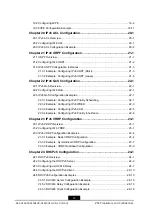
Chapter 2
IPv6 Address Configuration
Table of Contents
2.1 IPv6 Address Overview
IPv6 Address Introduction
Internet Protocol (
) version 6 is a new IP protocol, designed to replace IP version 4,
the Internet protocol that is predominantly deployed and extensively used throughout the
world.
However, the original design did not anticipate the following conditions:
l
Recent exponential growth of the Internet and the impending exhaustion of the Internet
Protocol version 4 (
) address space.
l
Growth of the Internet and the ability of Internet backbone routers to maintain large
routing tables.
l
Need for simpler auto configuration and renumbering.
l
Requirement for security at the IP level.
l
Need for better support to real-time delivery of data, also called Quality of Service
Note:
Features such as IP Security Protocol (
) and QoS have been specified for both
versions of IP.
Internet Protocol Version 6 (
) features a huge address capacity up to 128 bits, which
is described as follows:
l
It
provides
2128
different
IPv6
addresses,
that
is,
the
number
of
the
allocable
addresses
around
the
world
is
340,282,366,920,938,463,463,374,607,431,768,211,456.
l
It provides 2.2*10
20
addresses per cm
2
if addresses are allocated based on ground
area.
2-1
SJ-20140504150128-018|2014-05-10 (R1.0)
ZTE Proprietary and Confidential
















































